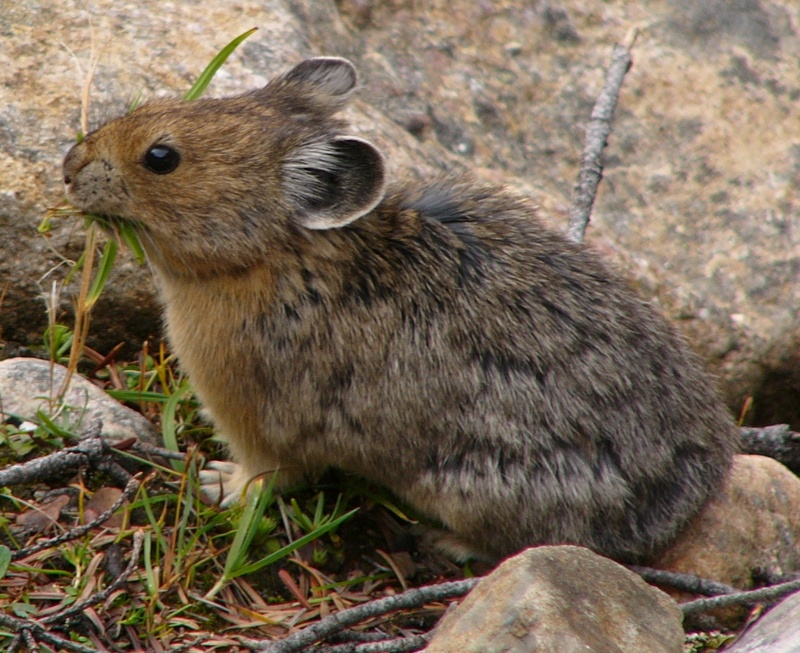American Pika (Ochotona princeps) - Wiki American Pika
From Wikipedia, the free encyclopedia
Order: Lagomorpha
Family: Ochotonidae
[Photo] An American Pika, Ochotona princeps, feeding on grass in the Canadian Rocky Mountains. Date: 1 September 2004. Author: Sevenstar. Public domain by the author. Source: http://en.wikipedia.org/wiki/Image:Ochotona_princeps_rockies.JPG
The American Pika (Ochotona princeps) is a diurnal species of pika that is found in the mountains of western North America, usually in boulder fields at or above tree line. They are flower-gathering animals, which are the smallest of the rabbit group.
Description
The American Pika has a small, round, egg-shaped body, which is covered with brown fur. They have large and round ears, and no visible tail. Their body length ranges from 162 to 216 millimeters (6-8 inches). Their hind feet range from 25 to 35 mm (1-1½ in). They usually weigh about 170 grams (6 ounces).
Distribution and habitat
The American Pika can be found throughout western North America, spanning from central British Columbia in Canada to the US states of Oregon, Washington, Idaho, Montana, Wyoming, Colorado, Nevada, California and New Mexico.
They generally reside in mountainous, rocky areas, within elevations of 2,400-4,000 meters (8,000-13,000 feet), or above the tree line. They make their homes in the cracks between piles of rocks. Although they live in groups, American Pikas are territorial and will guard their area from others.
Behavior
The American Pika is diurnal, or active throughout the day. They devote most of the day to searching for food, guarding their territory, and watching for predators, which includes: eagles, hawks, coyotes, bobcats, foxes, and weasels.
As the pika is a vocal animal, they can use both calls and songs to communicate among themselves. A call is used to warn when a predator is lurking near, and a song is during the breeding season (males only), and during autumn (both males and females).
Diet
The American pika is a flower-gathering herbivore. They will eat a large variety of green plants, including different kinds of grasses, sedges, thistles and fireweed. When they find food, they will eat a portion of it and take the rest for safekeeping in a pile, for use during the winter season.
This pika will move the pile around in order to protect it from various kinds of weather. After it has dried, the pika will then move it into its den. During the summer season, pikas feed on short alpine grasses, and on their stored food during the winter. If their food supplies are low during the winter, they will search either for lichens or cushion plants, which can be accessible by their underground tunnels.
Conservation and decline
The American Pika was placed on the IUCN Red List at a risk of Least Concern.
Recent studies suggest that species populations are declining due to various factors, most notably Global Warming. A 2003 study, published in the Journal of Mammology, showed that 9 out of 25 sampled populations of American Pika had disappeared, causing biologists to conclude that the species is reaching extinction.
As they live in the high and cooler mountain regions, they are very sensitive to high temperatures, and are considered to be one of the best early warning systems for detecting global warming in the western United States. Because their regular habitat's temperature rises, the American Pikas move higher up the mountain. Scientists report that pikas can die within an hour if the outside temperature reaches above 23°C (75°F).
http://en.wikipedia.org/wiki/American_Pika
| The text in this page is based on the copyrighted Wikipedia article shown in above URL. It is used under the GNU Free Documentation License. You may redistribute it, verbatim or modified, providing that you comply with the terms of the GFDL. |
